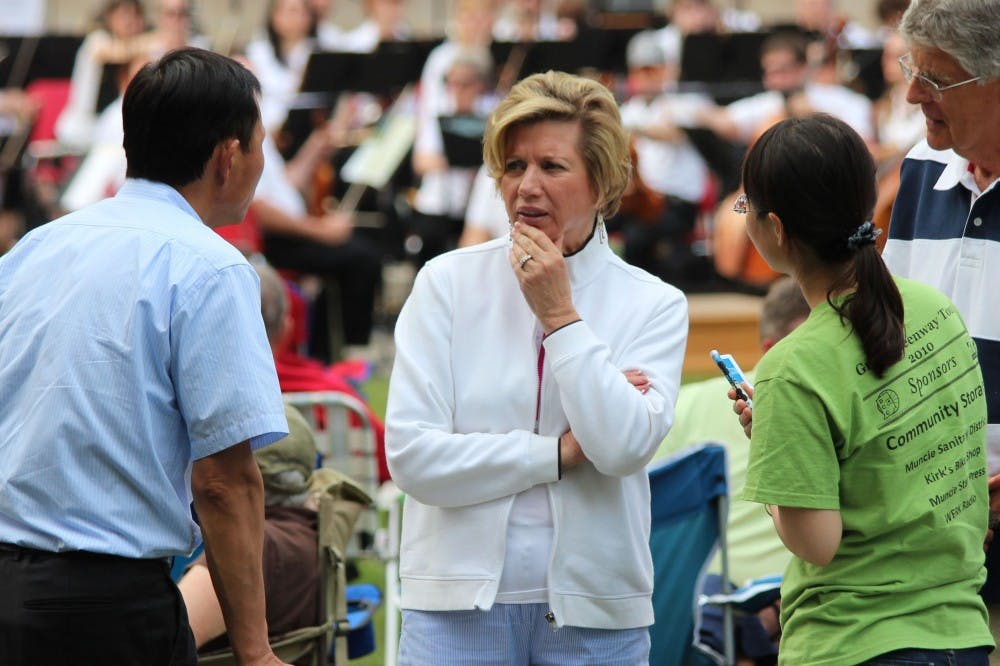Jo Ann Gora’s first days as Ball State president in 2004 weren’t without challenges.
The search committee that hired Gora faced complaints from faculty and students about the methods of the search, including the decision not to release any names of the finalists during the process — a first for the university.
Jayson Manship, Student Government Association president at the time, criticized student representation on the search committee in a statement during the search.
“Students have always been underrepresented when it comes to governance-related issues,” he said in a 2004 statement. “Apparently, the students have once again been overlooked.”
Faculty members also were agitated about their relationship with the Board of Trustees.
“The university is in turmoil; students and faculty are upset about the presidential search,” Joseph Losco, Department of Political Science chairperson, said to the Daily News in 2004. “President [Blaine] Brownell was a good go between. His departure came at a very inopportune time and relations with the board have deteriorated. We think with relations the way they are, it’s irresponsible to give full accreditation.”
The university also was involved in a multimillion dollar lawsuit after a University Police Department officer shot and killed student Michael McKinney while responding to a burglary call.
The McKinney family had filed against Ball State.
Marilyn Buck, associate provost and dean of University College, said to the Daily News in 2004 that the lawsuit did not affect the university’s search for a president.
Since then, Gora has battled declining state funding and promoting immersive learning as a viable learning strategy during her 10-year run.
Education Redefined strategic plan
In 2007, Gora launched the strategic plan Education Redefined. It lasted until 2012 and focused on immersive learning.
The initiative became the “hallmark” of a Ball State education.
During that time period, about 16,400 students from all seven colleges in the university partnered with community members for immersive learning projects.
Ball State Bold: Investing in the Future campaign
Following Education Redefined, the university set a $200 million fundraising goal.
It exceeded the goal by more than $10 million.
The money went toward funding campus improvements, such as scholarships, the creation of new immersive learning opportunities and campus renovations.
Afterward in March 2011 at the Indiana Statehouse, the university introduced 55 Bold Celebration Scholars.
Education Redefined 2.0: Advancing Indiana
The Board of Trustees passed the second part of Education Redefined in December 2012.
The plan, which will last until 2017, focuses on making the university an asset and resource for the state, partially through immersive learning.
*Cardinal Commitment: Developing Champions *
Gora announced the Cardinal Commitment: Developing Champions capital campaign in April 2013.
By the end of 2014, the university estimates the campaign will raise $20 million for upgrading and renovating athletic facilities.
A new basketball and volleyball practice facility will be built next to Worthen Arena with a practice court, basketball locker rooms and expanded volleyball locker rooms.
The university will renovate the baseball and softball diamonds, install a new football team complex and a new golf practice facility will finalize the main objectives of the project.
Geothermal project
In May 2009, the university started a two-phase geothermal project.
Phase one was completed in March 2012 and Ball State was able to shut down two coal-fired boilers.
The second phase was put on pause when funding ran out after 1,800 boreholes were drilled on the south side of campus.
When complete, the system will provide heating and cooling to more than 45 buildings on campus.
The university estimates the system will save the university $2 million each year and reduce Ball State’s carbon footprint in half. It is the largest geothermal district energy system in the United States.
In May, the state approved $30 million to finish the project. According to the university, phase two will be completed in 2015.
Funding issues
After releasing the new strategic plan, Education Redefined 2.0, Gora received some criticism since Ball State continued losing state funding for six years.
The state used a performance-based funding formula, which focuses on on-time graduation and rewards graduates in STEM fields.
The strategic plan continued to focus on immersive learning rather than STEM degrees. One goal was for each undergraduate department to offer at least one immersive learning opportunity each year.
“I think this is the right strategy for the university,” Gora to the Daily News in February. “It is our hope that once we are able to speak with members of the legislature, that there will be recognition that a formula that is basically ‘one size fits all’ is not a formula that can work for every institution. This is not the best way to support higher education in Indiana.”
Gora said she would continue to push “quality” education over “quantity.”
Academic freedom controversy
Gora spoke out against the teaching of intelligent design in science courses, following the controversy involving astronomy assistant professor Eric Hedin’s Honors 296 course.
The Freedom From Religion Foundation sent a letter complaining that Hedin was teaching intelligent design in the class.
“The question is not one of academic freedom, but one of academic integrity,” she said. “Said simply, to allow intelligent design to be presented to science students as a valid scientific theory would violate the academic integrity of the course, as it would fail to accurately represent the consensus of science scholars.”
The university reviewed the course and is implementing annual reviews for each honors course.





